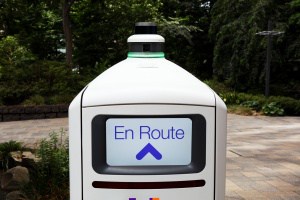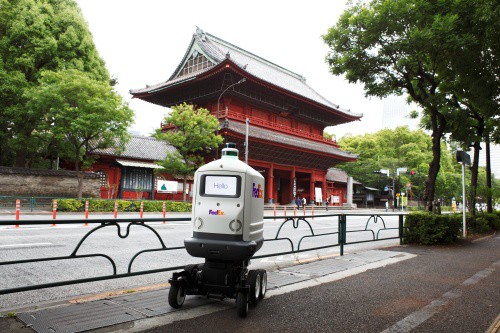Roxo, the same-day delivery robot developed by FedEx Express, has made its first appearance in Asia Pacific yesterday as the logistics firm expands Roxo’s trials onto the streets of Tokyo.
Envisioned as a last-mile logistics solution for urban and suburban areas, Roxo was developed in collaboration with DEKA Development & Research Corporation, the R&D company that also produced the Segway.
The robot uses DEKA’s established iBOT electric wheelchair base, capable of negotiating rough terrain, traversing steps, and steep inclines. Its sensors maintain 360-degree awareness of its surroundings and uses artificial intelligence, or AI, to choose the safest path or course of action. With a tall profile it is easy for pedestrians and road users to see. It also uses signals, lights and a signalling screen that clearly communicate its directional intent.
 Roxo is designed to travel on sidewalks and along roadsides, safely delivering smaller shipments to customers’ homes and businesses. Its features include pedestrian-safe technology, multiple cameras and LiDAR allowing the zero-emission, battery-powered bot to be aware of its surroundings.
Roxo is designed to travel on sidewalks and along roadsides, safely delivering smaller shipments to customers’ homes and businesses. Its features include pedestrian-safe technology, multiple cameras and LiDAR allowing the zero-emission, battery-powered bot to be aware of its surroundings.
Equipped with machine-learning algorithms to detect and avoid obstacles, plot a safe path, Roxo is enabled to follow road and safety rules. Proprietary technology makes it highly capable, allowing it to navigate unpaved surfaces, curbs, and to even climb deep flights of steps for an extraordinary door-to-door delivery experience.
The idea is simple. A customer orders a small item from a local merchant and – Roxo can deliver it right to a customer’s door within a 3-5 mile radius. Naturally, this takes some work: after all, no 2 sidewalks or driveways are exactly the same.
Japan: a fertile ground for robotics testing
Since Roxo was unveiled in 2019, FedEx Express has been conducting tests with major retailers in several US cities such as Memphis, Tennessee; Manchester, New Hampshire; and Plano and Frisco, Texas.
Roxo’s first international appearance was in Dubai, United Arab Emirates in October 2019 for an experimental project with local businesses, including Dubai Airports
Roxo is currently undergoing testing in the U.S. to generate data to ‘train’ the self-driving software and validate safe performance, in compliance with all applicable safety regulations and guidelines. There is significant opportunity in Japan to identify local, case-specific applications to make the best use of the technology to benefit FedEx customers.
 Meanwhile, FedEx Express picked Japan for Roxo’s first road test in Asia because it provides a fertile environment for testing and adoption of robotics with its positive regulatory framework and world-class infrastructure.
Meanwhile, FedEx Express picked Japan for Roxo’s first road test in Asia because it provides a fertile environment for testing and adoption of robotics with its positive regulatory framework and world-class infrastructure.
“As we sit at the intersection of physical and digital networks, Roxo brings a glimpse of the future of logistics, where customers can enjoy same day, contactless delivery services at their doorsteps,” said Kawal Preet, president of the Asia Pacific, Middle East, and Africa (AMEA) region at FedEx Express. “The FedEx SameDay Bot is truly an innovation opening new possibilities for on-demand, same day, hyper-localised delivery.”
With businesses of all kinds embarking on digital transformation, Preet said they look forward to collaborating with future-ready companies to advance delivery services in Japan and elsewhere in Asia Pacific.
“Let’s not forget the rest of Asia: a hugely diverse region of testing climates and extreme weather events; densely populated cities; unique public transport and varied terrains. No small challenge for an urban delivery bot,” Preet said.
She added: “Asia has long been a dynamic breeding ground for SMEs and driver of the entrepreneurial business culture that makes global trade what is it is today. Asia Pacific also remains a world leader in the development of smart, sustainable cities.
“One thing’s for sure: when we look at what’s next for Roxo in Asia-Pacific, it feels like innovation has landed in the right place.
ROXO: VITAL STATISTICS AT A GLANCE
Dimensions: 61.80” Height x 39” Length x 29” Width (H157 cm x L99 cm x W73 cm)
Weight: 450 lbs. approx. (200 kg)
Capacity: 100 lbs approx. (45 kg)
Sensors: A sophisticated set of sensors and technology gives 360-degree awareness
Built-in: Turn signals, lights, camera, microphone and signalling screen clearly communicate intent to nearby pedestrians, cyclists and vehicles
Zero-emissions: Battery powered
Stabilisation technology: iBot wheelchair base used to keep cargo level
Safety: Constantly monitored and capable of being controlled remotely
Watch surroundings through built-in cameras
Remote teleoperators can intervene and take over control
Remote teleoperator can communicate through built-in microphone


